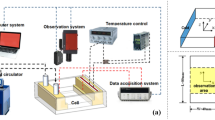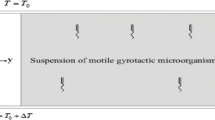Abstract
Microorganisms inhabit various natural environments and thrive in diverse ecosystems, including freshwater and marine bodies. Many of these microorganisms can swim and have a higher density than water, generating a vertical stratification of cell concentration that may lead to instability due to the buoyancy force. Biothermal convection refers to the convective motion that arises due to the combined effect of up-swimming microorganism and thermal gradients in a fluid medium. In the present work we investigate the onset of biothermal convection in a horizontal layer of cold water in the presence of the density inversion. This previously unexplored issue holds significance due to its potential applications in both natural and industrial contexts. We applied linear stability analysis to determine the critical thresholds at which instability initiates. To confirm these stability findings, we conducted numerical simulations using the finite volume method and compared them with the available experimental results in the case of penetrative convection. The critical threshold is shown to depend essentially upon the value of the density inversion parameter and the thermal Rayleigh number. Additionally, the linear stability analysis suggests the possible occurrence of Hopf bifurcations at the onset of motion.
Article Highlights
-
Biothermal convection stability depends on both the thermal Rayleigh number and the density inversion parameter.
-
The temperature stratification can either stabilize or destabilize, depending on the density inversion parameter.
-
An increase in the thermal Rayleigh number can introduces wave number transitions.













Similar content being viewed by others
Data availability
The data that support the findings of this study are available on request from the corresponding author.
References
Dehkharghani A, Waisbord N, Dunkel J, Guasto JS (2019) Bacterial scattering in microfluidic crystal flows reveals giant active Taylor-Aris dispersion. Proc Natl Acad Sci 116:11119–11124. https://doi.org/10.1073/pnas.1819613116
Williams CR, Bees MA (2011) Photo-gyrotactic bioconvection. J Fluid Mech 678:41–86. https://doi.org/10.1017/jfm.2011.100
Kuznetsov AV (2006) The onset of thermo-bioconvection in a shallow fluid saturated porous layer heated from below in a suspension of oxytactic microorganisms. Eur J Mech B Fluids 25:223–233. https://doi.org/10.1016/j.euromechflu.2005.06.003
Madigan M, Martinko J, Bender K, Buckley D, Stahl D (2014) Brock biology of microorganisms, 14th edn. Pearson, London
Williams CR, Bees MA (2014) Mechanistic modeling of sulfur-deprived photosynthesis and hydrogen production in suspensions of Chlamydomonas reinhardtii. Biotechnol Bioeng 111:320–335. https://doi.org/10.1002/bit.25023
Bees MA (2020) Advances in bioconvection. Annu Rev Fluid Mech 52:449–476. https://doi.org/10.1146/annurev-fluid-010518-040558
Pedley TJ, Kessler JO (1992) Hydrodynamic phenomena in suspensions of swimming microorganisms. Annu Rev Fluid Mech 24:313–358. https://doi.org/10.1146/annurev.fl.24.010192.001525
Hill NA, Pedley TJ (2005) Bioconvection. Fluid Dyn Res 37:1–20. https://doi.org/10.1016/j.fluiddyn.2005.03.002
Childress S, Levandowsky M, Spiegel EA (1975) Pattern formation in a suspension of swimming microorganisms: equations and stability theory. J Fluid Mech 63:591–613. https://doi.org/10.1017/S0022112075001577
Kessler JO (1986) The external dynamics of swimming micro-organisms. Progress Psycol Res Biopress Bristol 4:257–307. https://doi.org/10.1017/S0022112086001131
Pedley TJ, Hill NA, Kessler JO (1988) The growth of bioconvection patterns in a uniform suspension of gyrotactic micro–organisms. J Fluid Mech 195:223–237. https://doi.org/10.1017/S0022112088002393
Ghorai S, Hill NA (1999) Development and stability of gyrotactic plumes in bioconvection. J Fluid Mech 400:1–31. https://doi.org/10.1017/S0022112099006473
Ghorai S, Hill NA (2000) Wavelengths of gyrotactic plumes in bioconvection. Bull Math Biol 62:429–450. https://doi.org/10.1006/bulm.1999.0160
Ghorai S, Hill NA (2000) Periodic arrays of gyrotactic plumes in bioconvection. Phys Fluids 12:5–22. https://doi.org/10.1063/1.870249
Ghorai S, Hill NA (2002) Axisymmetric bioconvection in a cylinder. J Theor Biol 219:137–152. https://doi.org/10.1006/jtbi.2002.3077
Ghorai S, Singh R, Hill NA (2015) Wavelength selection in gyrotactic bioconvection. Bull Math Biol 77:1166–1184. https://doi.org/10.1007/s11538-015-0081-9
Bees M, Hill N (1997) Wavelengths of bioconvection patterns. J Exp Biol 200:1515–1526. https://doi.org/10.1242/jeb.200.10.1515
Hopkins M, Fauci L (2002) A computational model of the collective fluid dynamics of motile micro-organisms. J Fluid Mech 455:149–174. https://doi.org/10.1017/S0022112001007339
Vincent RV, Hill NA (1996) Bioconvection in a suspension of phototactic algae. J Fluid Mech 327:343–371. https://doi.org/10.1017/S0022112096008579
Ghorai S, Hill NA (2005) Penetrative phototactic bioconvection. Phys Fluids 17:074101. https://doi.org/10.1063/1.1947807
Abe T, Nakamura S, Kudo S (2017) Bioconvection induced by bacterial chemotaxis in a capillary assay. Biochem Biophys Res Commun 483:277–282. https://doi.org/10.1016/j.bbrc.2016.12.152
Chakraborty S, Ivancic F, Solovchuk M, Sheu TWH (2018) Stability and dynamics of a chemotaxis system with deformed free-surface in a shallow chamber. Phys Fluids 30:071904. https://doi.org/10.1063/1.5038613
Hillesdon AJ, Pedley TJ (1996) Bioconvection in suspensions of oxytactic bacteria: linear theory. J Fluid Mech 324:223–259. https://doi.org/10.1017/S0022112096007902
Thakker CD, Ranade DR (2002) An alkalophilic Methanosarcina isolated from Lonar crater. Curr Sci 82:455–458
Saiki T, Kimura R, Arima K (1972) Isolation and characterization of extremely thermophilic bacteria from hot springs. Agric Biol Chem 36:2357–2366. https://doi.org/10.1080/00021369.1972.10860589
Liu Y, Yao T, Jiao N, Kang S, Huang S, Li Q, Wang K, Liu X (2009) Culturable bacteria in glacial meltwater at 6,350 m on the East Rongbuk Glacier, Mount Everest. Extremophiles 13:89–99. https://doi.org/10.1007/s00792-008-0200-8
Jansson J, Tas N (2014) The microbial ecology of permafrost. Nat Rev Microbiol 12:414–425. https://doi.org/10.1038/nrmicro3262
Kuznetsov AV (2005) The onset of bioconvection in a suspension of gyrotactic microorganismsin a fluid layer of finite depth heated from below. Int Commun Heat Mass Transf 32:574–582. https://doi.org/10.1016/j.icheatmasstransfer.2004.10.021
Kuznetsov AV (2005) Investigation of the onset of thermo-bioconvection in a suspension of oxytactic microorganisms in a shallow fluid layer heated from below. Theor Comput Fluid Dyn 19:287–299. https://doi.org/10.1007/s00162-005-0167-3
Kuznetsov AV (2005) Thermo-bioconvection in a suspension of oxytactic bacteria. Int Commun Heat Mass Transf 32:991–999. https://doi.org/10.1016/j.icheatmasstransfer.2004.11.005
Kuznetsov AV (2011) Bio-thermal convection induced by two different species of microorganisms. Int Commun Heat Mass Transf 38:548–553. https://doi.org/10.1016/j.icheatmasstransfer.2011.02.006
Kuznetsov AV (2011) Nanofluid bio-thermal convection: simultaneous effects of gyrotactic and oxytactic micro-organisms. Fluid Dyn Res 43:055505. https://doi.org/10.1088/0169-5983/43/5/055505
Kuznetsov AV (2013) The onset of bio-thermal convection induced by a combined effect of gyrotactic and oxytactic microorganisms. Int J Numer Methods Heat Fluid Flow 23:979–1000. https://doi.org/10.1108/HFF-09-2011-0178
Kuznetsov AV (2016) Biothermal convection and nanofluid bioconvection. In: Johnson RW (ed) Handbook of fluid dynamics. CRC Press, Boca Raton
Nield DA, Kuznetsov AV (2006) The onset of bio-thermal convection in a suspension ofgyrotactic microorganisms in a fluid layer: oscillatory convection. Int J Therm Sci 45:990–997. https://doi.org/10.1016/j.ijthermalsci.2006.01.007
Karimi A, Ardekani AM (2013) Gyrotactic bioconvection at pycnoclines. J Fluid Mech 773:245. https://doi.org/10.1017/jfm.2013.415
Sommer T, Danza F, Berg J, Sengupta A et al (2017) Bacteria-induced mixing in natural waters. Geophys Res Lett 44:9424–9432. https://doi.org/10.1002/2017GL074868
Steiner OS, Bouffard D, Wüest A (2021) Persistence of bioconvection-induced mixed layers in a stratified lake. Limnol Oceanogr 9999:1–17. https://doi.org/10.1002/lno.11702
Moore DR, Weiss NO (1973) Nonlinear penetrative convection. J Fluid Mech 61(3):553–581. https://doi.org/10.1017/S0022112073000868
Kell George S (1975) Density, thermal expansivity, and compressibility of liquid water from 0° to 150°C: correlations and tables for atmospheric pressure and saturation reviewed and expressed on 1968 temperature scale. J Chem Eng Data 20(1):97–105. https://doi.org/10.1021/je60064a005
Pikuta EV, Hoover RB, Tang J (2007) Microbial extremophiles at the limits of life. Crit Rev Microbiol 33:183–209. https://doi.org/10.1080/10408410701451948
Cheregi O, Ekendahl S, Engelbrektsson J, Strömberg N, Godhe A, Spetea C (2019) Microalgae biotechnology in Nordic countries - the potential of local strains. Physiol Plant 166:438–450. https://doi.org/10.1111/ppl.12951
Schulze PSC, Hulatt CJ, Morales-Sánchez D, Wijffels RH, Kiron V (2019) Fatty acids and proteins from marine cold adapted microalgae for biotechnology. Algal Res 42:101604. https://doi.org/10.1016/j.algal.2019.101604
Santiago M, Ramírez-Sarmiento CA, Zamora RA, Parra LP (2016) Discovery, molecular mechanisms, and industrial applications of cold-active enzymes. Front Microbiol 7:1408. https://doi.org/10.3389/fmicb.2016.01408
Bees MA, Croze OA (2014) Mathematics for streamlined biofuel production from unicellular algae. Biofuels 5:53–65. https://doi.org/10.4155/bfs.13.66
Kessler JO (1986) Individual and collective fluid-dynamics of swimming cells. J Fluid Mech 173:191–205. https://doi.org/10.1017/S0022112086001131
Moore DR, Weiss NO (1973) Nonlinear penetrative convection. J Fluid Mech 61:553–581. https://doi.org/10.1017/S0022112073000868
Antar BN (1987) Penetrative double-diffusive convection. Phys Fluids 30:322–330. https://doi.org/10.1063/1.866381
Large E, Andereck CD (2014) Penetrative Rayleigh-Bénard convection in water near its maximum density point. Phys Fluids 26:094101. https://doi.org/10.1063/1.4895063
Patankar SV (1980) Numerical heat transfer and fluid flow. McGraw Hill, New York
Mamou M, Vasseur P, Hasnaoui M (2001) On numerical stability analysis of double-diffusive convection in confined enclosures. J Fluid Mech 433:209–250. https://doi.org/10.1017/S0022112000003451
Bearon RN, Grünbaum D (2006) Bioconvection in a stratified environment: experiments and theory. Phys Fluids 18:127102. https://doi.org/10.1063/1.2402490
Hill NA, Pedley TJ, Kessler JO (1989) Growth of bioconvection patterns in a suspension of gyrotactic micro-organisms in a layer of finite depth. J Fluid Mech 208:509–543. https://doi.org/10.1017/S0022112089002922
Pérez-Reyes I, Dávalos-Orozco LA (2019) Bioconvective linear stability of gravitactic microorganisms. Heat Mass Transf Adv Sci Technol Appl Alfredo Iranzo IntechOpen. https://doi.org/10.5772/intechopen.83724
Sato N, Sato K, Toyoshima M (2018) Analysis and modeling of the inverted bioconvection in Chlamydomonas reinhardtii: emergence of plumes from the layer of accumulated cells. Heliyon 4:e00586. https://doi.org/10.1016/j.heliyon.2018.e00586
Funding
No funding was received for conducting this study.
Author information
Authors and Affiliations
Contributions
Study conception and design: I.A. and R.O. Stability analysis and numerical simulations: I.A., R.O. and Z.A. Analysis and interpretation of results: I.A., R.O.,T.N.G. and Z.A. Revision of the manuscript: I.A., R.O.,T.N.G. and Z.A.
Corresponding author
Ethics declarations
Conflict of interest
The authors declare that they have no conflict of interests.
Additional information
Publisher's Note
Springer Nature remains neutral with regard to jurisdictional claims in published maps and institutional affiliations.
Rights and permissions
Springer Nature or its licensor (e.g. a society or other partner) holds exclusive rights to this article under a publishing agreement with the author(s) or other rightsholder(s); author self-archiving of the accepted manuscript version of this article is solely governed by the terms of such publishing agreement and applicable law.
About this article
Cite this article
Alloui, I., Ouzani, R., Nguyen-Quang, T. et al. Effect of density maximum of water on the stability of gravitactic convective motions in biothermal convection. Environ Fluid Mech (2024). https://doi.org/10.1007/s10652-024-09981-1
Received:
Accepted:
Published:
DOI: https://doi.org/10.1007/s10652-024-09981-1




